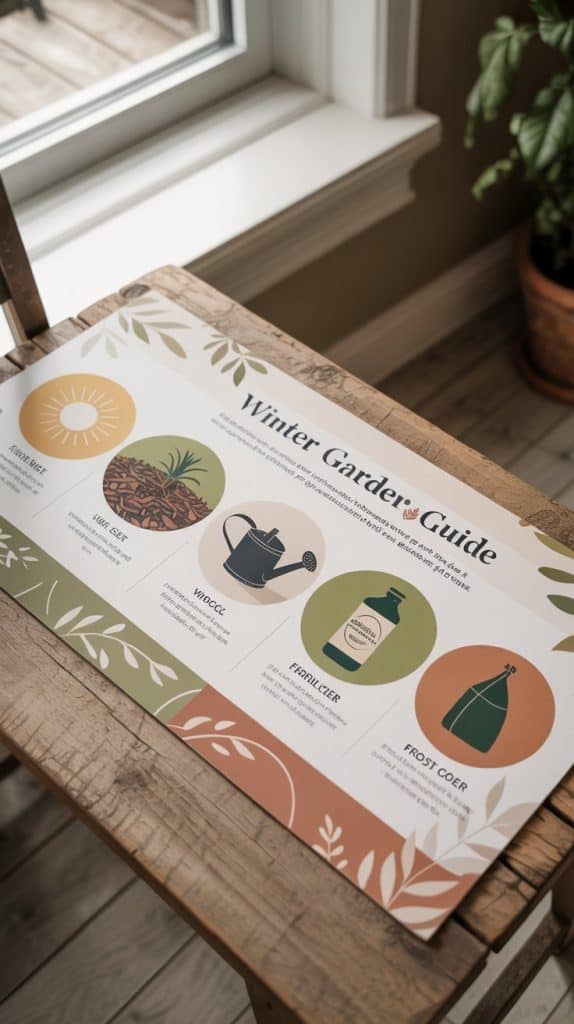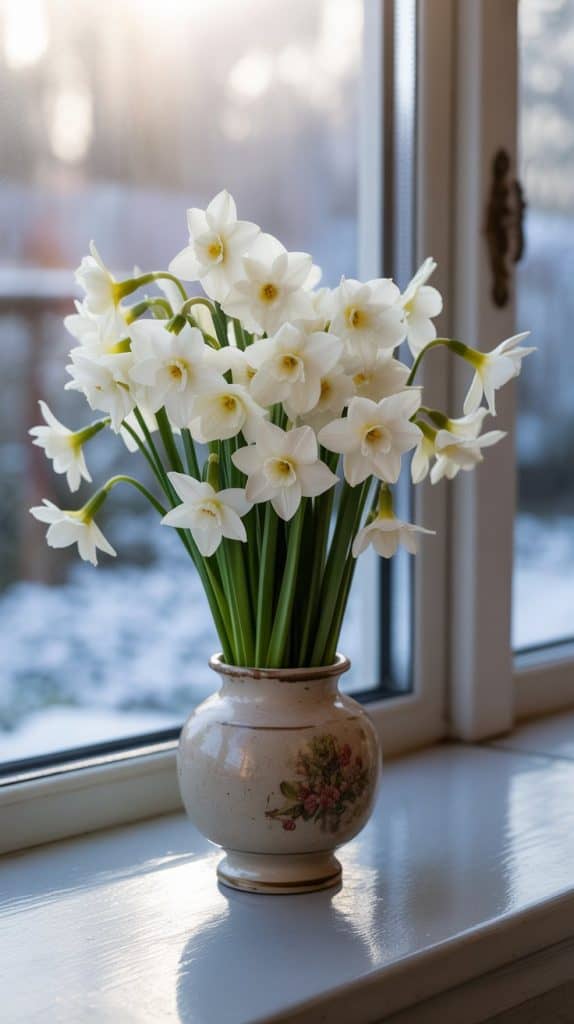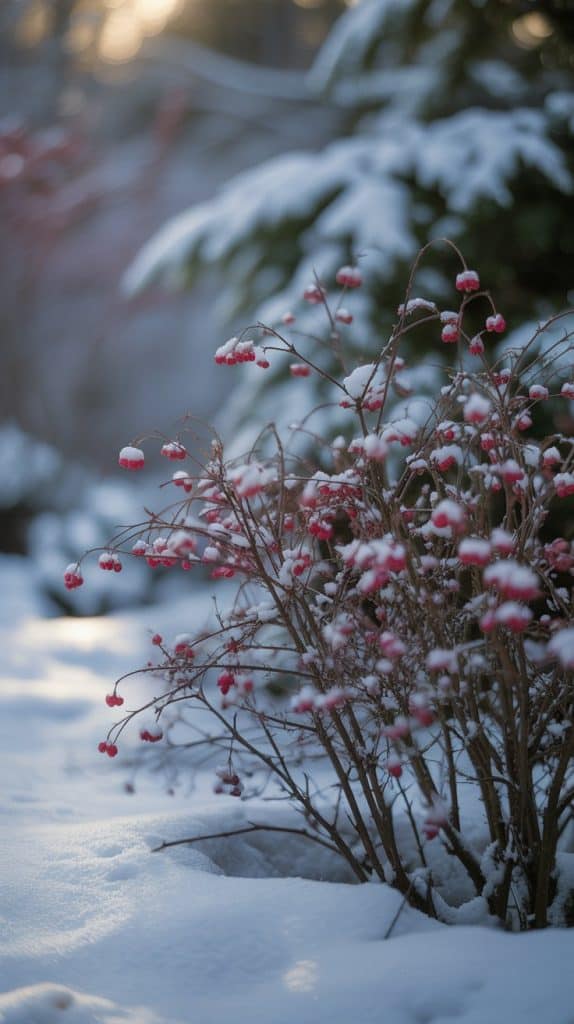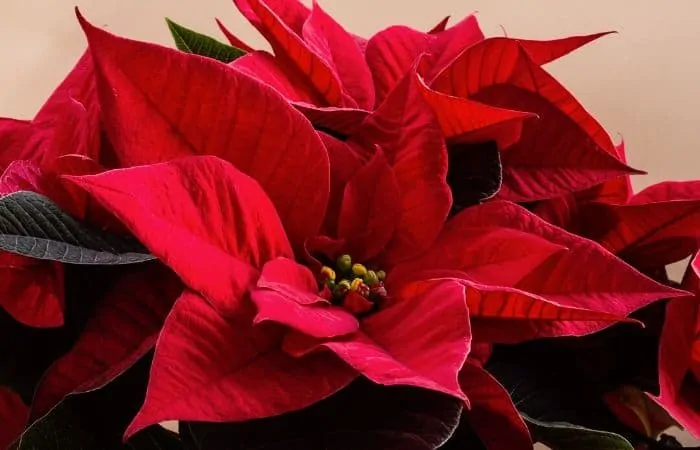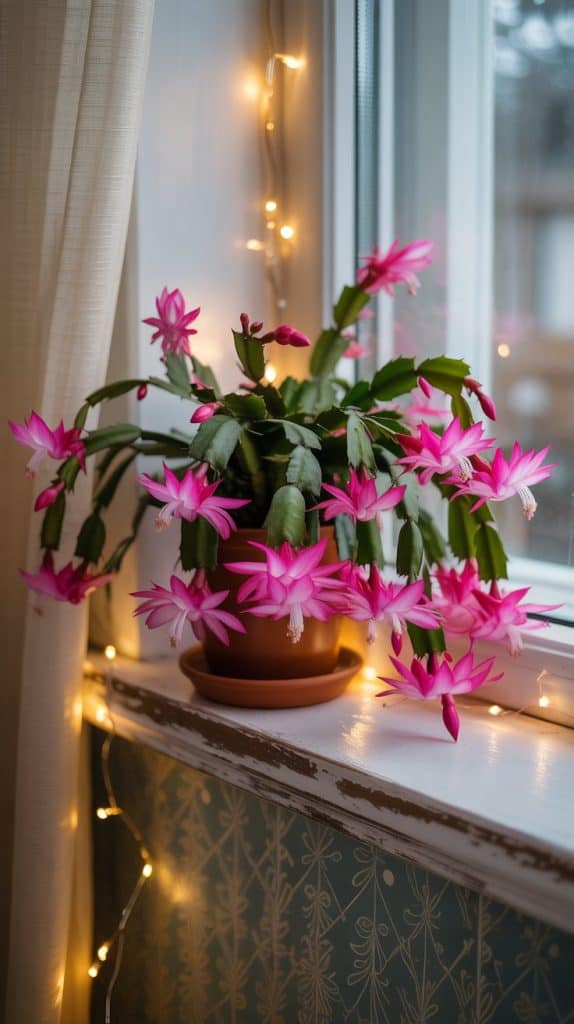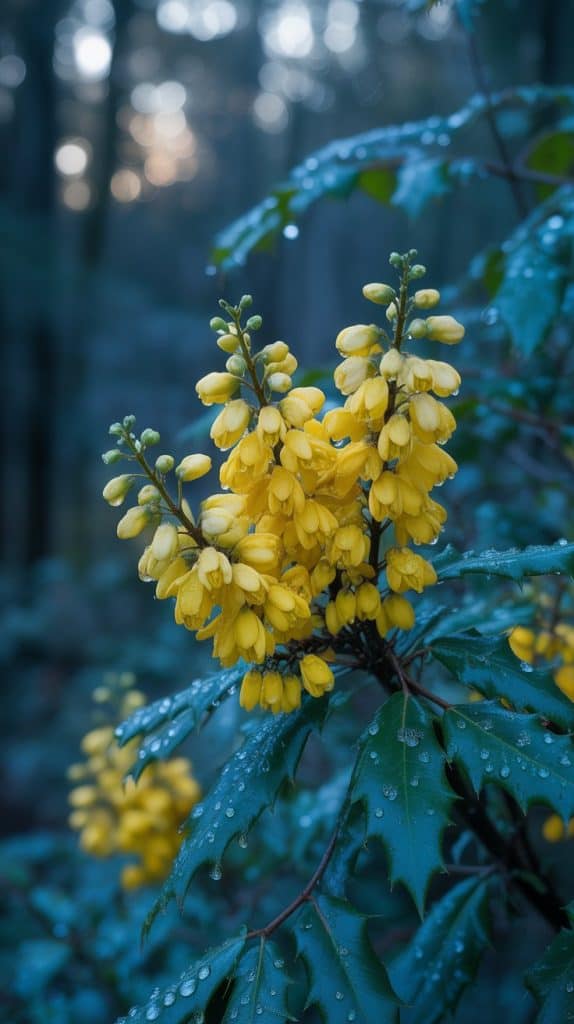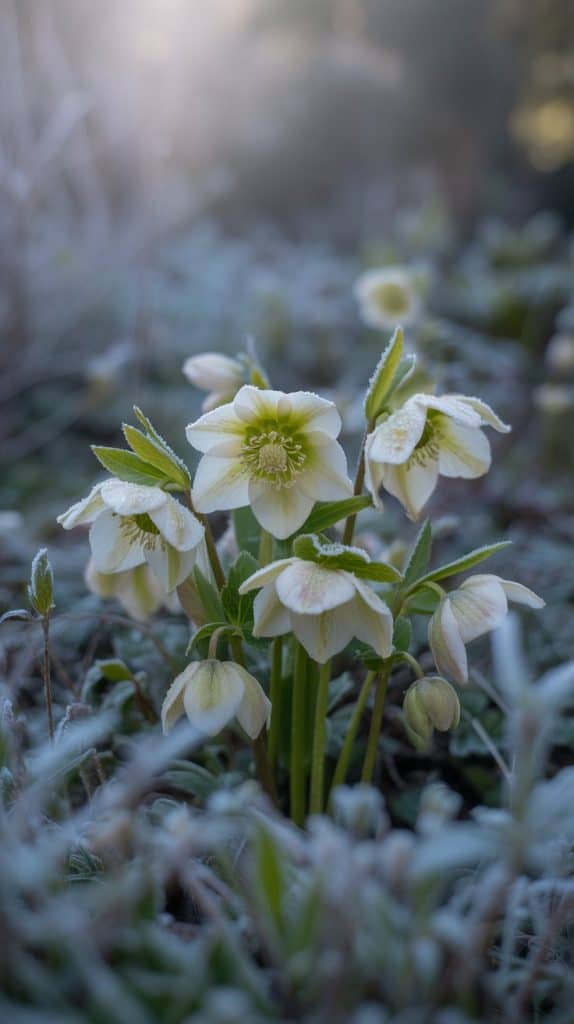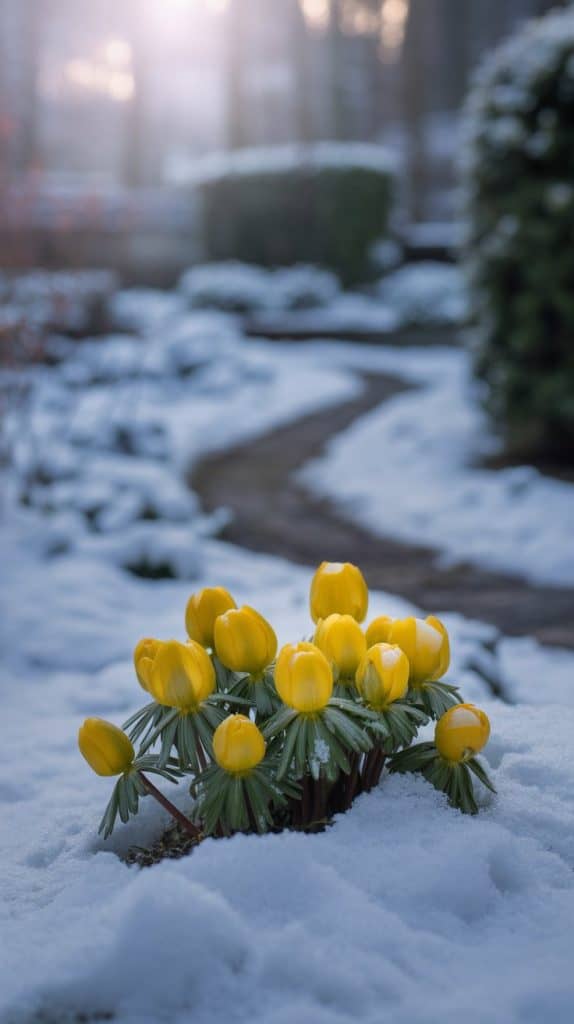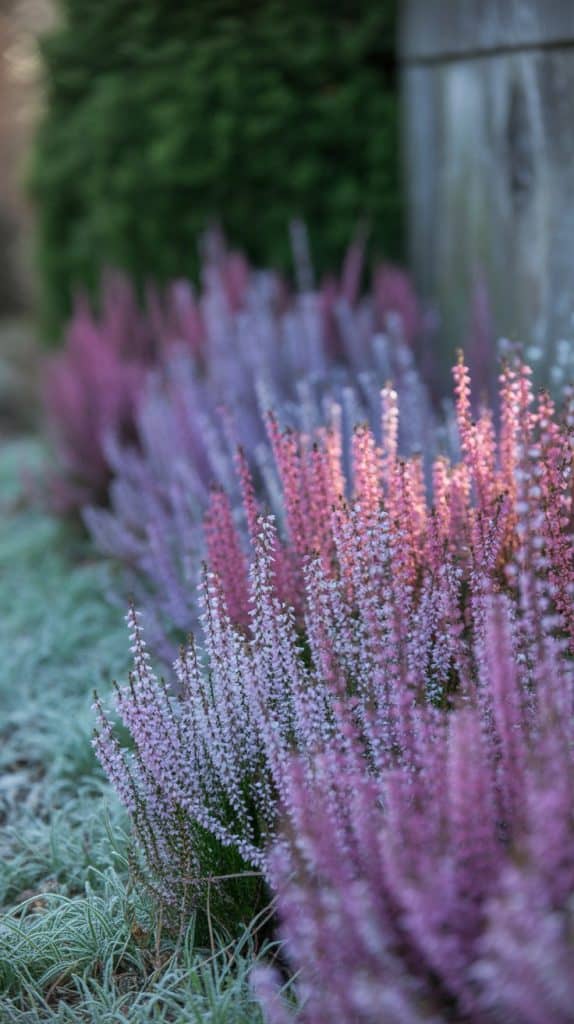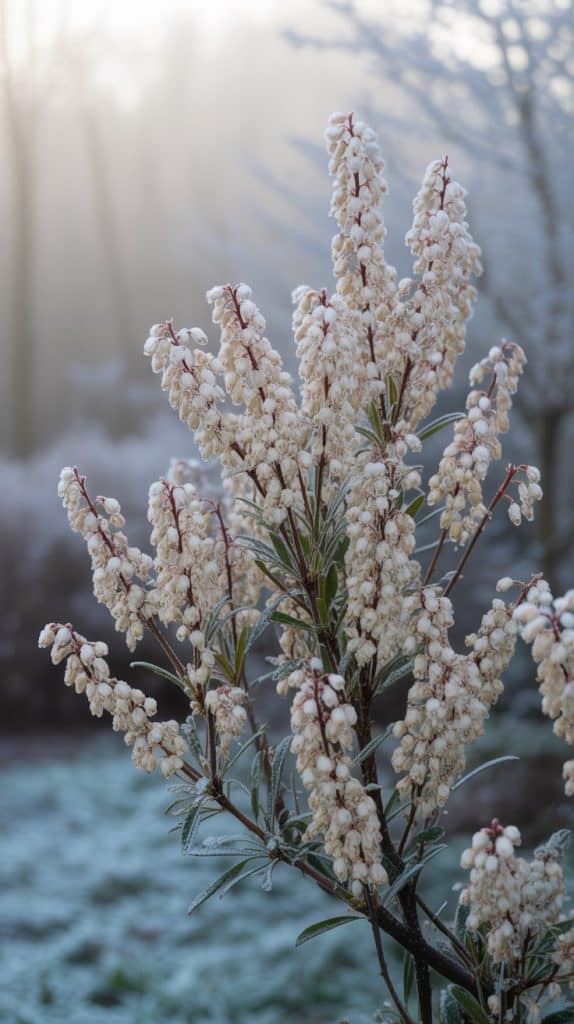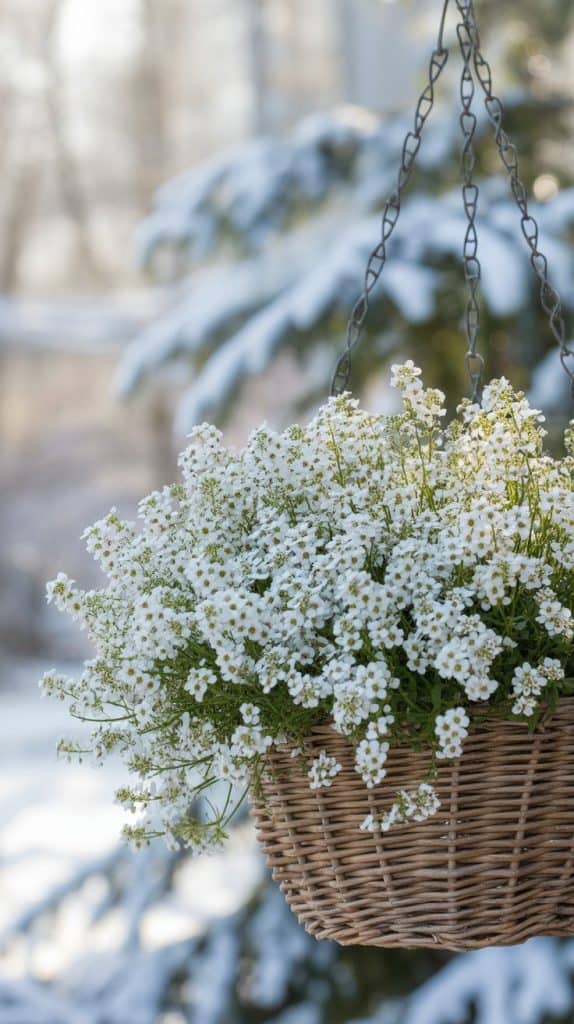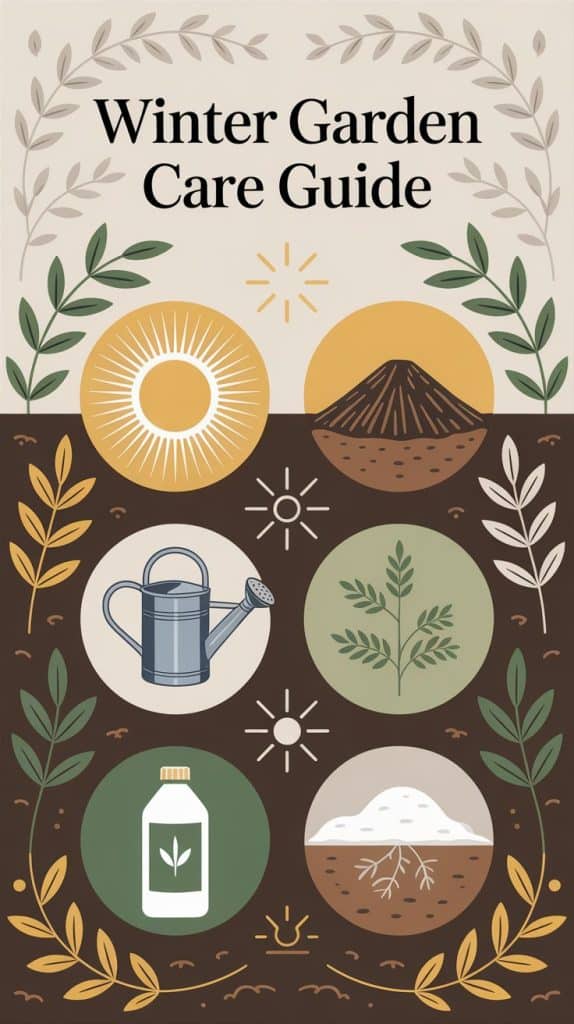Winter gardens have their own quiet beauty—soft light, crisp air, and blooms that thrive in the chill. You don’t have to give up color or fragrance just because the temperature drops. There are plenty of hardy plants that love the cold and reward your care with stunning, long-lasting flowers.
Before you dive into the list, learn a few quick winter care rules every gardener should follow.
You May Also Like-How to care Portulaca (Moss Rose) in Winter?
Winter Garden Care Guide (Infographic Content)
1. Choose the Right Spot: Most winter flowers prefer 4–6 hours of sunlight. Place pots near a sunny wall or veranda.
2. Use Mulch: Add mulch or compost mulch around the base—this holds warmth and moisture.
3. Avoid Overwatering: Winter plants need less water. Wait for the topsoil to dry before watering again.
4. Feed Lightly: Use a balanced liquid fertilizer once a month—heavy feeding is unnecessary.
5. Protect from Frost: Cover flowers with a thin fleece or move pots near walls during frosty nights.
December may bring chill, but it doesn’t mean your garden has to go dull. With the right plants, winter can be one of the most colorful seasons of the year. Many flowers thrive in cold weather and even bloom through light frost, filling your garden with cheer.
Here are fifteen hardy flowers that love winter and can make your December garden glow with life and fragrance.
Paperwhite Narcissus
Paperwhites are delicate, sweet-scented flowers that bring freshness indoors or outdoors. They grow easily from bulbs and need very little soil—just some pebbles and water are enough to get them started. In mild climates, they can even bloom outdoors through early winter.
Growing Tips: Keep them in bright light and rotate the pot weekly for straight growth.
Care Tips:
Light: Bright indirect light or mild winter sun.
Water: Keep slightly moist; do not flood bulbs.
Soil: Loose, well-drained compost mix or even plain pebbles with water.
Bloom Time: Early winter to mid-January.
Fun Fact: Paperwhites can bloom even without soil—just in water and pebbles!
Zones: 8–11
Cyclamen
This plant’s pink and white flowers seem delicate, but Cyclamens are surprisingly tough in cool weather. They love partial shade and do well in balconies, patios, and shaded corners of the garden. Their heart-shaped leaves and butterfly-like petals add grace to any winter space.
Growing Tips: Keep the soil lightly moist and avoid direct watering on the crown to prevent rot.
Care Tips:
Light: Partial shade; avoid bright mid-day sun.
Water: Keep soil evenly moist; water from below when possible.
Soil: Loose, porous mix rich in organic matter.
Bloom Time: November to February.
Fun Fact: Cyclamen tubers go dormant in summer and rebloom when the weather cools again.
Zones: 6–9
Winterberry
Winterberry (Ilex verticillata) brightens the season with its rich red berries that stay long after leaves fall. It’s an attractive shrub that also invites birds to your garden. Native to colder regions, it adapts well to Indian hill climates and cooler plains.
A deciduous holly shrub, Winterberry sheds its leaves in fall but entertains all winter with bright red berries. It provides color, structure, and food for birds during cold months. Perfect for hedges or mixed borders in mild regions of North India or the hills.
Growing Tips: Plant one male and one female plant for berry production.
Care Tips:
Light: Full sun to light shade.
Water: Moderate; prefers evenly moist soil.
Soil: Slightly acidic and well-drained soil.
Note: Plant male and female together for berries.
Fun Fact: Winterberry berries last for months, even under snow or frost.
Zones: 3–9
Poinsettia
Famous for its bold red and green foliage, Poinsettia is the star of holiday decorations. While usually kept indoors, it can thrive in covered verandas or patios if the temperature stays above 10°C.
The symbolic flower of Christmas, Poinsettia, is loved for its festive red bracts (colored leaves). In India, they do well as indoor or shaded porch plants in winter and last long with a little care.
Care Tip: Water moderately and keep humidity up. Avoid cold drafts.
Care Tips:
Light: Bright but indirect sunlight.
Water: Water when the soil feels dry; avoid soggy roots.
Temperature: Keep between 15°C-22°C.
Fun Fact: The red “petals” are actually leaves called bracts—the real flowers are tiny yellow centers.
Zones: 9–11
Violas
Violas are among the quickest ways to add winter color. Their cheerful faces bloom through frost, making them a must-have for pots, borders, and hanging baskets. They’re smaller cousins of pansies and bloom reliably through the season.
Violas are tough, cheerful, and bloom prolifically in cool climates. They love the Indian winter and thrive in pots, boxes, or borders. Their dainty faces come in yellows, purples, and whites.
Care Tip: Remove spent flowers regularly for continuous blooms.
Care Tips:
Light: Full sun to partial shade.
Soil: Well-drained, compost-rich soil.
Water: Regular but moderate watering.
Fun Fact: Violas reseed naturally, bringing back surprises next season.
Zones: 4–9
Christmas Cactus
A popular indoor bloomer, the Christmas Cactus (Schlumbergera) flowers around the holiday season with pink or red tubular petals. It prefers cooler rooms and indirect light, making it perfect for Indian homes in December.
Care Tip: Allow the soil to dry between waterings, and avoid direct afternoon sun.
Care Tips:
Light: Bright, indirect light.
Water: Water when top topsoil feels dry; do not overwater.
Temperature: 15°C–20°C.
Fun Fact: This plant originated in Brazil’s mountain forests, not deserts, and enjoys humidity!
Zones: Indoor
Mahonia
Mahonia stands out in cold gardens with its bold, spiky leaves and golden flower clusters. It blooms reliably through winter in hilly or temperate regions, adding rich color and fragrance when most plants are resting.
Also called Oregon Grape, Mahonia is an evergreen shrub producing golden flower spikes in winter. It’s tough, low-maintenance, and attracts bees even in cold weather.
Care Tip: Plant in partial shade and keep the soil slightly moist.
Care Tips:
Light: Partial shade.
Water: Regular watering, avoid dry roots.
Soil: Moist, rich loamy soil.
Fun Fact: The yellow flowers later turn into blue-black berries loved by birds.
Zones: 5–8
Bergenia
Known as “pigsqueak” for its thick leaves, Bergenia produces clusters of pink blooms that withstand frost. It’s ideal as ground cover for shaded areas or stone borders.
Bergenia are sturdy perennials with thick, leathery leaves and pink or purple clusters of blooms. Their leaves stay evergreen, adding winter texture and color even without flowers.
Growing Tip: Water moderately and keep the soil well-drained to ensure optimal growth.
Care Tips:
Light: Partial shade to filtered sun.
Soil: Moist but well-drained.
Bloom Time: Late December to February.
Fun Fact: When rubbed, their large leaves squeak—earning the name “Pigsqueak.”
Zones: 3–8
Hellebore (Lenten Rose)
Hellebores are classic winter-blooming perennials, with nodding flowers that appear in shades of white, pink, purple, and green. Their blooms last for weeks, often pushing through frosty ground.
Growing Tip: Best planted in shaded, well-drained areas. Low maintenance once established.
Care Tips:
Light: Light shade.
Water: Moderate; don’t let roots stay soaked.
Soil: Fertile, well-drained soil enriched with compost.
Fun Fact: Hellebores are deer-resistant and bloom when little else dares to.
Zones: 4–9
Winter Aconite
These cup-shaped golden flowers bloom early and brighten any dull corner. Their short height makes them perfect for rock gardens or borders beneath trees.
Growing Tip: Plant bulbs in the fall for December blooms.
Care Tips:
Light: Partial sun.
Soil: Moist, humus-rich.
Planting: Sow bulbs in autumn.
Fun Fact: These flowers symbolize rebirth—emerging even through the last snow of winter.
Zones: 4–7
Skimmia
Skimmia is both ornamental and fragrant. Its glossy leaves and red berries make it perfect for shaded gardens. Even in low light, Skimmia remains green and vibrant through the cold months.
Growing Tip: Ensure good drainage and slightly acidic soil.
Care Tips:
Light: Partial or full shade.
Water: Moderate moisture.
Soil: Slightly acidic, rich soil.
Fun Fact: Male and female plants bloom separately, so plant both for berries.
Zones: 6–9
Heather
Heather adds warmth to the cold season with carpets of pink, white, and purple flowers. It’s low-growing and long-blooming, ideal for rockeries and pathway edges.
Growing Tip: Prefers sandy, well-drained soil and full to partial sunlight.
Care Tips:
Light: Full sun.
Soil: Sandy, slightly acidic.
Water: Light, regular watering.
Fun Fact: Heather is a symbol of luck and protection in many cultures.
Zones: 5–8
Pieris Japonica
This evergreen shrub develops pearl-white buds in late winter that open into small bell-shaped flowers. It’s a favorite for shaded beds and containers.
Also called the Lily-of-the-Valley shrub, Pieris Japonica has glossy evergreen leaves and countless white bell-shaped buds that appear in winter. These buds add ornamental appeal even before spring.
Growing Tip: Keep soil consistently moist but not soggy. Avoid strong afternoon sun.
Care Tips:
Light: Light to partial shade.
Soil: Moist, acidic soil.
Water: Keep consistently moist.
Fun Fact: New shoots grow red in spring, adding two seasons of color interest.
Zones: 5–8
Camellia Sasanqua
Camellias brighten late autumn and winter with their graceful blooms. The Sasanqua variety flowers earlier than most, showing soft pink and white petals around December. It loves cool, bright locations and moist, acidic soil.
A refined winter bloomer, Camellia Sasanqua showcases soft pink and white flowers on glossy foliage. It’s among the earliest camellias, blooming from late November through January.
Care Tips:
Light: Partial shade to filtered light.
Water: Regular; avoid full drought.
Soil: Rich, acidic.
Fun Fact: The Camellia’s petals were historically used for tea and hair oil in East Asia.
Sweet Alyssum
Small but fragrant, Sweet Alyssum creates a cloud of white or lavender blooms. It’s especially good for pots, edging paths, and hanging baskets. The honey-like fragrance makes it a favorite for pollinators even in mild winters.
One of the easiest and most rewarding flowers for Indian winters, Sweet Alyssum spreads like a delicate white carpet. Tiny blooms release a honey-like fragrance that fills the air. It’s perfect for garden edges, baskets, or pots.
Care Tip: Give full to partial sun and water regularly.
Care Tips:
Light: Full to partial sun.
Soil: Light, well-drained, moderately fertile.
Water: Low to moderate; drought-tolerant.
Fun Fact: Alyssum attracts pollinators like bees and butterflies in cooler weather.
Zones: 7–10
FAQs
Also Read: How to Prepare Your Garden for a Christmas Party?
Can I plant new flowers in December?
Yes. Hardy perennials like cyclamen, pansies, and hellebores can be planted during winter in mild or temperate regions. They adapt well to cold soil.
Which flowers survive frost in India?
Pansies, violas, dianthus, and calendulas do exceptionally well in Indian winters, especially in northern plains and hill areas.
How can I protect flowers from frost?
Add a thin mulch layer, water early in the day, and move potted plants near walls or verandas for overnight protection.
Do indoor winter bloomers need sunlight?
Yes, but only bright, indirect light. Place plants like Christmas Cactus or Poinsettia near a window with filtered sun.

